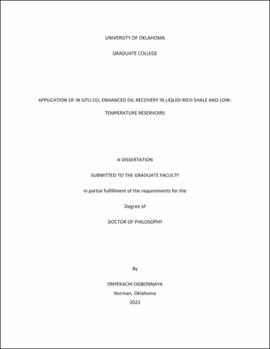| dc.description.abstract | The injection of CO2 presents significant potential for enhancing oil production while minimizing environmental impact by storing CO2 within the oil reservoir. However, the realization of this potential is hindered by factors such as limited inexpensive CO2 sources, lack of infrastructure for CO2 transportation, early gas breakthrough, gravity segregation, viscous fingering, low solubility of CO2 in water, and asphaltene deposition, among others. To address these challenges, alternative methods to deliver CO2 to the target oil reservoir through in-situ generation of CO2 are explored. Specifically, we used aqueous solutions of urea as the CO2 gas generating agent due to its low cost, availability, ease of handling, high solubility in aqueous solutions, tolerance to high salinity conditions and high yield of CO2.
This dissertation comprises of two major topics. The first topic focused on the development of effective in-situ CO2 enhanced oil recovery (ICE) formulations for liquid-rich shale reservoirs while the second topic focused on the application of ICE in low-temperature reservoirs. The first study was conducted in two phases. In the first phase we used dodecane as the oil phase, while crude oil was used in the second phase. We study the synergistic effects of coupling urea with a thermally stable anionic surfactant to further improve oil recovery performance from low-permeability shale formations. We designed the oil recovery experimental procedures to simulate the huff-n-puff technique. Imbibition tests were carried out with oil-saturated Woodford outcrop shale cores for different soaking periods. To assess recovery performance and mechanisms, tests were conducted with four different formulations: brine only, urea in brine, thermostable anionic surfactant in brine, and a blend of urea and surfactant in brine. Surfactant stability at the test temperature was investigated. Furthermore, interfacial tension (IFT) and wettability alteration tests were conducted to understand their effect on total recovery. In addition, the oil recovery experiments were tested at below and above MMP conditions to help decipher the principal recovery mechanism. Results revealed that the selected enhanced oil recovery (EOR) recipes are stable at reservoir conditions and compatible with the oil samples. There was no significant difference in oil recovery when the test pressure was below or above MMP, which suggests that the oil recovery process involved immiscible CO2 mechanism. Furthermore, we observed that both IFT reduction and wettability alteration play critical roles in improving oil recovery. For the tests performed with dodecane-saturated shale cores, combining the surfactant with urea did not have any synergistic benefits. This was attributed to the strong water wetness of the dodecane-saturated shale core samples. Moreover, the urea-only case could recover up to 24% of the original oil in place (OOIP) compared to about 6% for the brine-only case, 21% for the surfactant-only case and 22% for the ternary urea/surfactant/brine mixture. For the tests performed with crude oil-saturated shale cores, aging the shale cores in crude oil changed the wettability of the cores from water-wet to oil-wet. We observed a favorable synergistic effect when we combined the surfactant with urea, leading to higher oil recovery after a 14-day soaking period. The oil recovered in the case of 14-days soaking time for the brine only, binary brine/urea, binary brine/surfactant, and ternary urea/surfactant/brine mixture was 7%, 9%, 5%, and 18% of the OOIP, respectively.
The second topic of this research focused on the application of ICE in low-temperature reservoirs. We used a naturally occurring enzyme (urease) to catalyze the generation of in-situ CO2 under low-temperature reservoir conditions. This study was conducted in two phases. The first phase was conducted with highly purified commercially available urease and deionized (DI) water was used as the aqueous phase, while the second phase was conducted with crude urease extracts from jack beans and artificial sea water (ASW) was used as the aqueous phase. We conducted batch tests to study the kinetics of the urease-catalyzed hydrolysis of urea at different temperatures and concentrations of urea and urease. Adsorption tests were conducted to study the adsorption of the enzyme on porous media. The extent of wettability alteration and the recovery mechanism for different lithologies was determined through core sample imbibition experiments and contact angle measurements. One-dimensional sand pack flowthrough experiments were conducted with different lithologies at 50 °C in the first phase and at 50 and 70 °C in the second phase, to evaluate the tertiary oil recovery potential of low-temperature ICE using the modified formulations. From the experimental results, urease-catalyzed urea hydrolysis is proven to be effective in generating CO2 at the test temperatures with urea conversion rate of up to 95 % at 50 °C for the crude urease extracts. The adsorption tests show that urease was significantly adsorbed on limestone surfaces while the adsorption on sandstone was insignificant. Imbibition tests of this improved formulation with various porous media show distinct wettability reversal trends towards a more water-wet state post-imbibition. For the tests with highly purified urease and DI water, the tertiary oil recovery was up to 31.3 % for sandstone at 50 °C. Meanwhile, for the tests with jack bean extracts and ASW, the tertiary oil recovery was up to 28.0 % for limestone at 50 °C. These results were better than the corresponding high temperature (120 °C) cases. Moreover, the tertiary oil recovery for the limestone and sandstone tests were lower at 70 °C compared to 50 °C. This was attributed to the higher solubility of CO2 in oil at lower temperatures. Overall, the simplicity of the technique used to produce the crude urease extract from jack beans will significantly reduce the cost of enzyme-catalyzed low-temperature ICE, thus overcoming a major barrier and enabling practical applications in the oilfield. | en_US |
